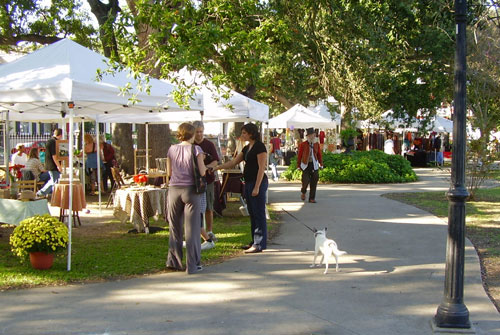Faubourg Marigny: New Orleans, Louisiana

Summary
Originally a Creole suburb, Faubourg Marigny is a 200-year-old community. Streets follow a sharp curve in the Mississippi, providing grand views as one walks, bikes, or drives. Respite for pedestrians can be found in several wide, landscaped avenues and two alleys of oak trees that surround the perimeter of Washington Square, the district's heart and soul. By day, this densely populated neighborhood of brightly painted cottages and shotgun houses beckons residents to its walkable streets, coffeehouses, and boutiques. By night, it is an entertainment destination with a distinctly bohemian vibe.
Designated Area
The 95-block Faubourg Marigny national historic district is nestled between New Orleans's Vieux Carre and Bywater neighborhoods and roughly bounded by Press Street to the east, Esplanade Avenue to the west, St. Claude Avenue to the north, and the Mississippi River to the south.
Planning Excellence
The faubourg is the site of numerous events and festivals throughout the year. The popular spring home tour is in its 38th year while the 24th annual Candlelight Christmas Caroling in Washington Square takes place this fall. With a history of community activism, Faubourg Marigny's character has been preserved due in large part to residents' willingness to embrace land-use regulations and guidelines designed to maintain and improve the neighborhood's quality of life.

Faubourg Marigny's striking architectural treasures, rotated grid system, and lively entertainment scene define this neighborhood and set it apart from the rest of New Orleans' 9th District. Photo courtesy Geoffrey Moen.
Historic Nature
- Established as a plantation in 1743, Faubourg Marigny owes its existence to Louisiana Purchase; Bernard Phillippe Xavier de Marigny de Mandeville, the plantation's owner, believed the transaction would stimulate demand for new housing and hired Nicholas de Finiels, an engineer, to plan the faubourg. To accommodate a 135-degree turn in Mississippi River, 1805 plan included a rotated grid system to continue streets from the Vieux Carre downriver into the new neighborhood, which allows for continuously unfolding views
- As Americans settled area upriver from the Vieux Carre, immigrants and free people of color populated Faubourg Marigny; diversity remains neighborhood hallmark
- Brightly painted one- and one-and-a-half story Creole and shotgun cottages — often flush with front property line — dominate housing stock; built close together on relatively small lots, define the scale and character of most streets. Outstanding examples of Greek, Italianate, and Craftsman architectural styles also exist
- Faubourg Marigny added to National Register of Historic Places in 1974
Mixed Uses
- Faubourg Marigny features land uses compatible with its residential character; for example, 2002 Residential Diversity Overlay District has brought commerce back to street corners
- City adopted Arts and Cultural Overlay District in 2004 to address neighborhood concerns as live entertainment venues emerged (along Frenchmen Street, for example); legalizing live music in many establishments mandated compliance with entertainment-related safety and building codes
- Washington Square is Marigny's outdoor living room; shaded benches, open central field, and children's playground attract residents and visitors; numerous events and festivals occur here throughout year
- Relocation of New Orleans Center for Creative Arts, the state's high school for the arts, to the faubourg in 2000 resulted in restoration of three historic warehouses and creation of a striking architectural monument

Shaded benches, an open central field, and children's playground make Washington Square Park Faubourg Marigny's year-round outdoor "living room." Photo courtesy Chris Costello.
Planning and Preservation Commitment
- To stem neighborhood's post–World War II decline, Preservation Plan for Faubourg Marigny was completed in 1971 by graduate students at Tulane University School of Architecture
- Specialized zoning approved in 1971 for triangular area adjacent to the Vieux Carre, limiting commercial uses in historically residential buildings; Historic Marigny Zoning extended to rest of neighborhood in 1977
- Historic structures demolition prohibited in 1978 when Faubourg Marigny became local historic district; city's Historic District Landmarks Commission approves design of all new structures
- Streetcar loop one of many improvements proposed in a 2001 neighborhood master plan by the Tulane School of Architecture and Faubourg Marigny Improvement Association, an influential group founded in 1972; since Hurricane Katrina, the Improvement Association has maintained Washington Square
- Improvement Association involved with a revitalization effort along St. Claude Avenue and development of New Orleans Master Plan and Comprehensive Zoning Ordinance to correct land uses and zoning residents deem incompatible with neighborhood character
History of Diversity and Affordability
- Since the first lots were sold in 1805, Faubourg Marigny has embraced people of all cultures; French-speaking Haitian refugees took up residence in 1809. Three decades later, large numbers of Germans were found in neighborhood; remains a cultural melting pot
- Relatively low property costs provide homeownership opportunities; affordable units mixed fairly evenly throughout the neighborhood (individual residences and small apartment buildings)
- Products, tastes, sights, and sounds of dozens of cultures found in the businesses, restaurants, and nightclubs peppering the faubourg
- Diversity evident in recently erected AIDS monument in Washington Square; made of concentric bronze circles framing inspirational multicultural cast-glass faces; monument serves as a memorial and sanctuary for victims' friends and family

Community involvement in both neighborhood planning events and planning initiatives has contributed to the preservation of Faubourg Marigny's distinct character. Photo courtesy Chris Costello.


